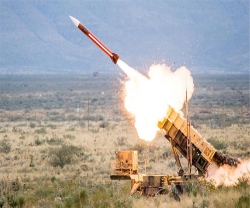'Bug Eye' to give troops better night vision
15.09.2009 Products
Frontline troops will soon be able to see better in the dark using a revolutionary new optical technology 'Bug Eye' that’s modelled on the eye of a tiny parasitic fly, said engineers at BAE Systems. The BAE team has developed the new ‘bug eye’ technology following several months of research examining the eye mechanisms of the Xenos peckii – a parasitic fly that lives on a wasp.
The tiny bug has 50 separate lenses in each eye. Each lens produces an individual image, which are meshed together to form a single large panoramic image in its brain, they said. Scientists have recreated this effect in the new imaging device, which includes nine lenses – each about the size of a mobile phone camera lens – arranged on a curved surface. The device provides a 60 degree field of view for a helmet mounted device and is both compact and lightweight giving troops much better manoeuvrability and situational awareness during night time missions, the team said.
Leslie Laycock, executive scientist at BAE Systems, said: 'There’s a requirement to reduce the size and weight of night vision goggles – and to achieve a wider field of view. Night time missions are an essential part of today’s military operations, but existing equipment only provides 30-40 degree field of vision, which restricts situational awareness on the ground.'
'Most the size and weight of a conventional lens is due to the glass — the actual optics. So, when we were thinking of ways to miniaturise the equipment, we looked at insects because they have tiny optics in their eyes, which provide high quality images.'
'The compound eyes of insects can often contain up to hundreds of thousands of tiny lenses. We didn't want to go to that level of complexity, but found the Xenos peckii with 50 larger lenses, which provided the high resolution and sensitivity that we required,' Laycock added.
The research into the technology was funded by a MoD programme designed to reduce the size and weight of imaging equipment used in a variety of military applications.
The ‘bug eye’ system is now being developed for missile tracking systems as well as night vision equipment. Existing missile guidance devices can only achieve about 20 degree field of vision — this means that the camera has to be attached to a mechanical mount and swivelled around to scan wide areas.
The insect-inspired technology provides the tracking system with 120 degree field of vision eliminating the need for accompanying hardware, which helps to minimise size and weight, while reducing maintenance costs.
Away from the military arena, the technology could help to improve security in public places by developing CCTV cameras that could survey panoramas of crowded spaces without any of the usual black spots associated with such systems. The multiple lenses could also zoom in on certain areas of a scene without affecting the rest of the image on the screen.
In the future, it could also be used in the medical field for key hole surgery, though this will require the scientists to shrink the system, which can currently be held in the palm of a hand, even further.
The tiny bug has 50 separate lenses in each eye. Each lens produces an individual image, which are meshed together to form a single large panoramic image in its brain, they said. Scientists have recreated this effect in the new imaging device, which includes nine lenses – each about the size of a mobile phone camera lens – arranged on a curved surface. The device provides a 60 degree field of view for a helmet mounted device and is both compact and lightweight giving troops much better manoeuvrability and situational awareness during night time missions, the team said.
Leslie Laycock, executive scientist at BAE Systems, said: 'There’s a requirement to reduce the size and weight of night vision goggles – and to achieve a wider field of view. Night time missions are an essential part of today’s military operations, but existing equipment only provides 30-40 degree field of vision, which restricts situational awareness on the ground.'
'Most the size and weight of a conventional lens is due to the glass — the actual optics. So, when we were thinking of ways to miniaturise the equipment, we looked at insects because they have tiny optics in their eyes, which provide high quality images.'
'The compound eyes of insects can often contain up to hundreds of thousands of tiny lenses. We didn't want to go to that level of complexity, but found the Xenos peckii with 50 larger lenses, which provided the high resolution and sensitivity that we required,' Laycock added.
The research into the technology was funded by a MoD programme designed to reduce the size and weight of imaging equipment used in a variety of military applications.
The ‘bug eye’ system is now being developed for missile tracking systems as well as night vision equipment. Existing missile guidance devices can only achieve about 20 degree field of vision — this means that the camera has to be attached to a mechanical mount and swivelled around to scan wide areas.
The insect-inspired technology provides the tracking system with 120 degree field of vision eliminating the need for accompanying hardware, which helps to minimise size and weight, while reducing maintenance costs.
Away from the military arena, the technology could help to improve security in public places by developing CCTV cameras that could survey panoramas of crowded spaces without any of the usual black spots associated with such systems. The multiple lenses could also zoom in on certain areas of a scene without affecting the rest of the image on the screen.
In the future, it could also be used in the medical field for key hole surgery, though this will require the scientists to shrink the system, which can currently be held in the palm of a hand, even further.
Latest news
Latest events
Defence Exhibition Athens - DEFEA
06 - 08 May 2025Metropolitan Expo Athens - GreeceLangkawi International Maritime & Aerospace Exhibition (LIMA)
20 - 24 May 2025Langkawi - MalaysiaParis Air Show
16 - 22 Jun 2025Paris Le Bourget - FranceDefenPol China2025 - 7th Guangzhou International Defense & Police Exhibition & Summit
11 - 12 Jul 2025Nan Fung International Convention & Exhibition Center (NICEC) - China






















